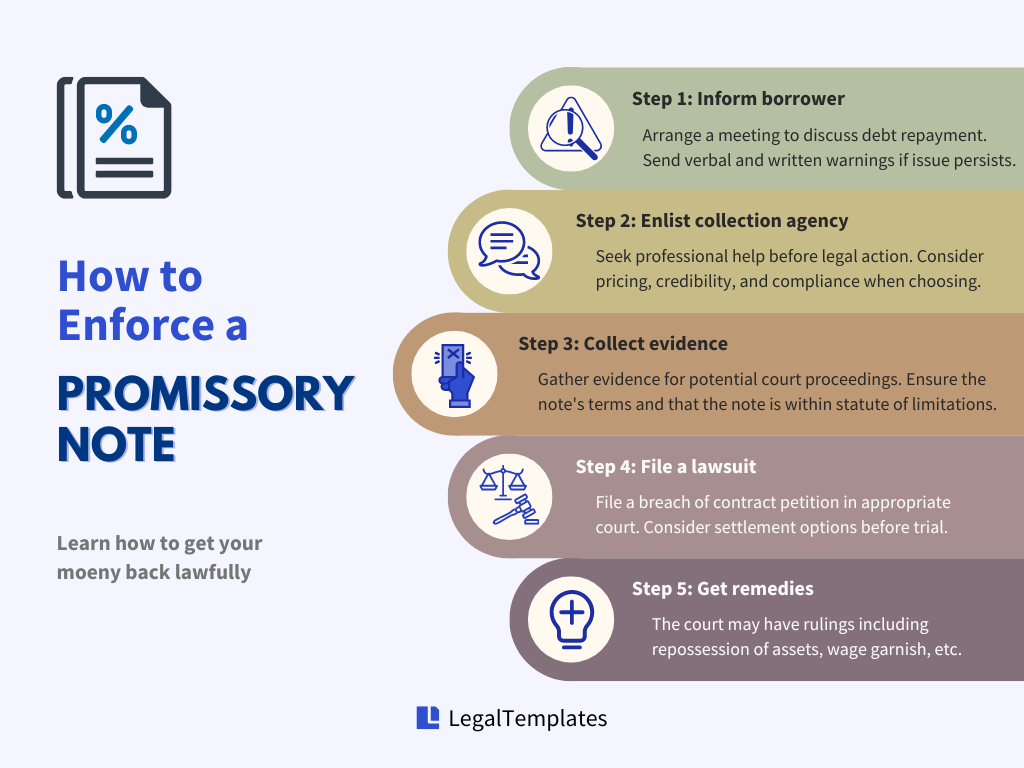
Enforcing a promissory note, whether secured or unsecured, can be challenging and lengthy when the borrower defaults. Read ahead and discover steps you can take to resolve your debts appropriately, including what evidence to collect for a lawsuit and legal remedies available for lenders like you.
The advice below may also help when it comes to enforcing an IOU form or a loan agreement.
How to Enforce a Promissory Note (5 Steps)

Step 1: Inform Borrower
Start by arranging a meeting with the borrower via traceable means such as email or chat apps to discuss the debt repayment.
Clear verbal communication about the debt before issuing a written notice may motivate the borrower to take action. Emphasize the possible consequences of nonpayment, including the enlistment of a debt collector, potential damage to their credit ratings, and future borrowing difficulties.
Tip
If the borrower is a close friend or family member struggling with debt, consider suggesting credit counseling.
If having a conversation about the loan doesn’t result in repayments, you may need to resort to written warnings. The written warnings provide clear notice about the actions you will take to enforce the promissory note’s terms.
First, send a demand letter. The demand letter must include the following:
- The name of the borrower
- The date of the promissory note
- The amount owed
- The payment date/s or installment amounts
You must also include a few sentences regarding the nature of the demand in the letter. For example – “If the amount owed is not paid by the date specified, I will be taking legal action to recover the amount owed.”
If there is no response from the borrower after sending the Notice Letter, you should attempt to send a follow-up letter. The follow-up letter should include the following:
- The date and nature of the previous demand letter sent
- Reinforcement of the details included in the last letter
- Restatement of steps that you will take should the borrower fail to make payments to repay the loan
Although this seems a little dramatic, it’s important to note that these written warnings aim to save both parties from the cost and time it takes for debt collection services to get involved or if the matter ends up in court.
Certified Mail
It is highly recommended to send your demand letters via certified mail so that you have a return receipt to prove that the borrower has received the letter.
Step 2: Enlist Collection Agency
If the borrower ignores your demand for repayment, it may be a good idea to get a professional collection agency involved before taking legal action. When choosing an agency, consider the following:
- Research and Compare Prices: Seek the best deal, keeping in mind that many agencies charge only upon successful collection.
- Professionalism and Credibility: These are crucial aspects of a reliable agency.
- No Recovery Guarantee: Even with a collection agency, there’s no certainty of fund recovery.
- Regulatory Compliance: Ensure the agency is legitimate (not a fake debt collector) and follows the Fair Debt Collection Practice Act, avoiding false, misleading, unfair, or deceptive practices.
Step 3: Collect Evidence
If the collection agency’s efforts are ineffective, you should start collecting evidence to go to court.
The evidence you need to present in court may vary by state. In California, for example, a breach of contract requires the following factual elements to be presented to recover damages from the borrower:
- Agreement from both parties (i.e., the original promissory note);
- Lender’s fulfillment of the contract’s duties (i.e., records of having collected debt responsibly and timely, receipt of the demand letter via certified mail);
- Clear statements in the contract of all the terms the borrower needs to meet;
- Borrower’s failure to meet a requirement of the contract (i.e., nonpayment after maturity date) or violation of the contract (i.e., went on a holiday and did not pay the amount owed);
- Harm caused to the lender by the breach.
Before you take the matter to court, you must also ensure the amount of the outstanding debt and that the promissory note is within your state’s statute of limitations (generally the same as that of other written contracts).
Remember, the burden of proof is on you, meaning you are responsible for proving to the judge that the nonpayment happened.
How much time do I have to collect the debt?
Generally speaking, if the outstanding debt is a lump sum due on a specific date, the statute begins from that date. In the case of installment payments, the statute can vary depending on your state. Check your local laws and precedents; consult an attorney for the most accurate information.
Step 4: File a Lawsuit
Since promissory notes are legally binding documents, taking the matter to court is your best chance at getting the borrowed money back if all effort fails.
However, this is the point where you should stop and think about your goals and whether gaining the money-back balances out the time and cost it will take. Remember that settling the case outside of court will be much cheaper and less time-consuming than taking it to trial. There is also a chance the judge may not rule in your favor.
If you have made up your mind, you should start by calling your local clerk at the civil court in your district to ask about specific procedures for filing. You should also consider contacting an attorney to obtain information on the rules and what you need to prepare for the lawsuit.
Most lenders file a petition under a breach of contract. Depending on the amount owed and the circumstances of the debt, your petition will most likely need to be filed at the Civil Courts in the borrower’s district. Each state and circumstance will differ in the application process.
You should file the case as limited (usually less than $25,000), unlimited (greater than $25,000), or a small claims case depending on the amount owed and the state where the lawsuit is filed. In most cases, the petition to enforce a promissory note will require an attorney’s signature.
You must file the petition in the district court where the borrower lives.
Tip
Attorneys generally cannot practice (i.e., represent a client) in small claims court; however, they can still advise clients on small claims issues and strategy.
Step 5: Get Legal Remedies
For a Secured Promissory Note
If you have a court order, you can repossess whatever asset you and the borrower agreed on as collateral when you signed the promissory note.
How you can repossess the collateral depends on the asset and state law. For instance, if the collateral is a car, the lender will usually contract with a third-party tow service to tow the car away to a place designated by the lender. (Note that the court will not help enforce the order for you.)
If the borrower is willing to transfer the collateral’s legal ownership to you voluntarily, you don’t need a court order. However, ensure that 1) the borrower provides evidence for the value of the collateral (i.e., the fair market value of a vehicle) and that 2) the value of the repossessed asset covers the outstanding balance. The borrower is still responsible for the remaining amount if the value is insufficient.
If you have neither a court order nor a cooperative borrower, check your state law to see if you can repossess the asset without a court order. For instance, a bank lender can repossess a car when the borrower defaults without a court order in Arkansas.
For an Unsecured Promissory Note
The ideal situation would be that the borrower has enough money to settle the unpaid debt. However, if the borrower cannot pay the amount owed, the court may judge to execute one (or more) of the following actions:
- Wage garnishment. The court orders the borrower’s employer to withhold a particular portion of their salary to be directly applied toward the debt. Depending on the court’s discretion, this can be deducted in installments or upfront.
- Bank levy. This allows a lender to take funds directly from a borrower’s bank account. Once a bank levy is issued, the bank freezes the borrower’s account and pays the funds to the lender to settle the debt.
- Seizure of asset. The court allows the lender to take possession of certain assets or properties of the borrower. These assets are then sold, and the proceeds are used to repay the debt.
- Lien against real estate. The court grants a claim or legal right against the borrower’s property. This means the borrower cannot sell the property without settling the debt. If the property is sold, the proceeds must first be used to pay off the debt before the borrower can receive any money from the sale.
You may also be entitled to recover some of the costs of filing the lawsuit. Decided by the courts, these may be included in ‘damages’ repaid, including interest, attorney fees, and court costs.
Can the borrower be punished for nonpayment?
Most states don’t allow extra penalties for nonpayment, apart from compensating the lender for their losses. However, local rules can vary. If you feel you’re due more than just repayment, it’s wise to check local laws or consult an attorney.
After Complete Repayment
Once the borrower has fully repaid the debt, you as the lender have the responsibility to release the borrower from the obligations of the promissory note. This is done by issuing the borrower a promissory note release form.
The release form officially confirms that the borrower has fulfilled their obligations under the terms of the note and that the lender has no further claim.
Selling the Note: What to Do if All Fails
If you have exhausted all other options and still cannot retrieve the debt, you may need to sell the promissory note to a vendor.
Remember that you will not get the total value of the note (usually around 60-90% of the value), so this is your last option. Should you choose to sell the note, your loss will be significant as vendors that buy these promissory notes often purchase them at a great deal less than the loan’s value, leaving you with very little at the end of the process.
To sell the note, contact various buyers and try to find the best deal. You can always negotiate on price, just like any other product or service sale. However, be careful and ensure you are selling the note to an established company with the knowledge and capability to handle the sale of your note.
Important
Check the terms and conditions of your promissory note before attempting to sell it. If it’s specifically written that it’s non-negotiable — meaning that its legal ownership cannot be transferred — you cannot sell the note.
In Summary
Here are some final tips for your debt recovery:
- Be proactive, firm, yet reasonable when dealing with the borrower;
- Always maintain a paper trail of all conversations and payments;
- Do your research and be careful when dealing with debt collection agencies;
- Check the local rules or contact an attorney for the documents needed.
Enforcing a promissory note can be complex, but it’s crucial for safeguarding your finances. Professional help may be needed, particularly when selecting a collection agency or in legal proceedings. Always adhere to regulations like the Fair Debt Collection Practices Act, respecting the borrower’s rights.
